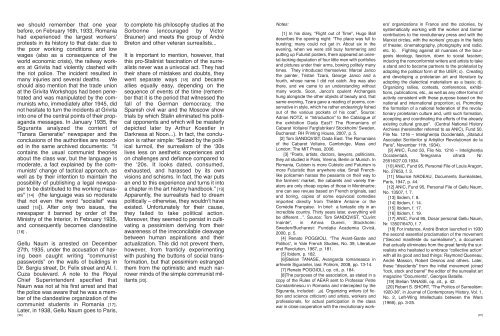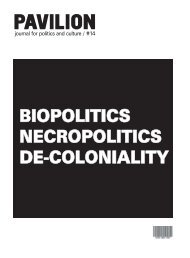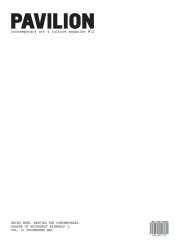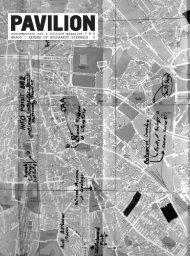Download pdf version of issue no. 16 (4 Mb) - Pavilion
Download pdf version of issue no. 16 (4 Mb) - Pavilion
Download pdf version of issue no. 16 (4 Mb) - Pavilion
Create successful ePaper yourself
Turn your PDF publications into a flip-book with our unique Google optimized e-Paper software.
we should remember that one year<br />
before, on February <strong>16</strong>th, 1933, Romania<br />
had experienced the largest workers’<br />
protests in its history to that date: due to<br />
the poor working conditions and low<br />
wages (also as a consequence <strong>of</strong> the<br />
world eco<strong>no</strong>mic crisis), the railway workers<br />
at Grivita had violently clashed with<br />
the riot police. The incident resulted in<br />
many injuries and several deaths. We<br />
should also mention that the trade union<br />
at the Grivita Workshops had been penetrated<br />
and was manipulated by the communists<br />
who, immediately after 1945, did<br />
<strong>no</strong>t hesitate to turn the incidents at Grivita<br />
into one <strong>of</strong> the central points <strong>of</strong> their propaganda<br />
messages. In January 1935, the<br />
Siguranta analyzed the content <strong>of</strong><br />
“Tanara Generatie” newspaper and the<br />
conclusions <strong>of</strong> the authorities are recorded<br />
in the same archived documents: "it<br />
contains the usual communist theories<br />
about the class war, but the language is<br />
moderate, a fact explained by the communists'<br />
change <strong>of</strong> tactical approach, as<br />
well as by their intention to maintain the<br />
possibility <strong>of</strong> publishing a legal newspaper<br />
to be distributed to the working masses"<br />
[14] (the language was so moderate<br />
that <strong>no</strong>t even the word "socialist" was<br />
used [15]). After only two <strong>issue</strong>s, the<br />
newspaper it banned by order <strong>of</strong> the<br />
Ministry <strong>of</strong> the Interior, in February 1935,<br />
and consequently becomes clandestine<br />
[<strong>16</strong>] .<br />
Gellu Naum is arrested on December<br />
27th, 1935, under the accusation <strong>of</strong> having<br />
been caught writing “communist<br />
passwords” on the walls <strong>of</strong> buildings in<br />
Dr. Sergiu street, Dr. Felix street and Al. I.<br />
Cuza boulevard. A <strong>no</strong>te to the Royal<br />
Chief Superintendent specified that<br />
Naum was <strong>no</strong>t at his first arrest and that<br />
the police was aware that he was a member<br />
<strong>of</strong> the clandestine organization <strong>of</strong> the<br />
communist students in Romania [17].<br />
Later, in 1938, Gellu Naum goes to Paris,<br />
[96]<br />
to complete his philosophy studies at the<br />
Sorbonne (encouraged by Victor<br />
Brauner) and meets the group <strong>of</strong> André<br />
Breton and other veteran surrealists...<br />
It is important to mention, however, that<br />
this pro-Stalinist fascination <strong>of</strong> the surrealists<br />
never was a univocal act. They had<br />
their share <strong>of</strong> mistakes and doubts, they<br />
went separate ways [18] and became<br />
allies equally easy, depending on the<br />
sequence <strong>of</strong> events <strong>of</strong> the time (remember<br />
that it is the period that witnessed the<br />
fall <strong>of</strong> the German democracy, the<br />
Spanish civil war and the Moscow show<br />
trials by which Stalin eliminated his political<br />
opponents and which will be masterly<br />
depicted later by Arthur Koestler in<br />
Darkness at Noon...). In fact, the conclusion<br />
is rather simple: “Seized by the political<br />
turmoil, the surrealism <strong>of</strong> the ‘30s<br />
lives less on aesthetic experiences and<br />
on challenges and defiance compared to<br />
the ‘20s. It looks dated, consumed,<br />
exhausted, and harassed by its own<br />
visions and schisms. In fact, the war puts<br />
an end to this experience and turns it into<br />
a chapter in the art history handbook.” [19]<br />
Apparently, the surrealists had to dream<br />
politically – otherwise, they wouldn’t have<br />
existed. Unfortunately for their cause,<br />
they failed to take political action.<br />
Moreover, they seemed to persist in cultivating<br />
a pessimism deriving from their<br />
awareness <strong>of</strong> the irreconcilable cleavage<br />
between human aspirations and their<br />
actualization. This did <strong>no</strong>t prevent them,<br />
however, from franticly experimenting<br />
with pushing the buttons <strong>of</strong> social transformation,<br />
but that pessimism estranged<br />
them from the optimistic and much narrower<br />
minds <strong>of</strong> the simple communist militants<br />
[20].<br />
Notes:<br />
[1] In his diary, “Flight out <strong>of</strong> Time”, Hugo Ball<br />
describes the opening night: “The place was full to<br />
bursting; many could <strong>no</strong>t get in. About six in the<br />
evening, when we were still busy hammering and<br />
putting up Futurist posters, there appeared an oriental-looking<br />
deputation <strong>of</strong> four little men with portfolios<br />
and pictures under their arms, bowing politely many<br />
times. They introduced themselves: Marcel Janco<br />
the painter, Tristan Tzara, George Janco and a<br />
fourth, whose name I did <strong>no</strong>t catch. Arp was also<br />
there, and we came to an understanding without<br />
many words. Soon, Janco's opulent Archangels<br />
hung alongside the other objects <strong>of</strong> beauty and, that<br />
same evening, Tzara gave a reading <strong>of</strong> poems, conservative<br />
in style, which he rather endearingly fished<br />
out <strong>of</strong> the various pockets <strong>of</strong> his coat”. Source:<br />
Adrian NOTZ, in “Introduction” to the Catalogue <strong>of</strong><br />
the exhibition Dada East? The Romanians <strong>of</strong><br />
Cabaret Voltaire/ Fargfabriken/ Stockholm/ Sweden,<br />
Bucharest: RH Printing House, 2007, p. 5.<br />
[2] Tom SANDQVIST, Dada East. The Romanians<br />
<strong>of</strong> the Cabaret Voltaire, Cambridge, Mass and<br />
London: The MIT Press, 2006.<br />
[3] “Poets, artists, doctors, lawyers, politicians,<br />
they all studied in Paris, Vienna, Berlin or Munich. In<br />
Romania, Cubism is more Cubistic and Futurism is<br />
more Futuristic than anywhere else. Small Frenchlike<br />
policemen harass the peasants on their way to<br />
the farmers’ market, the cabarets and variety theaters<br />
are only cheap copies <strong>of</strong> those in Montmartre;<br />
one can see revues based on French originals, sad<br />
and boring, copies <strong>of</strong> some equivocal comedies<br />
imported directly from Théâtre Antoine or the<br />
Comèdie Française. In brief: a fantastic city in an<br />
incredible country. Thirty years later, everything will<br />
be different…”. Source: Tom SANDQVIST, “Cuvînt<br />
înainte”, in Arhiva Durerii, Stockholm:<br />
Sweden/Bucharest: Fundația Academia Civică,<br />
2000, p. 5.<br />
[4] Renato POGGIOLI, “The Avant-Garde and<br />
Politics”, in Yale French Studies, No. 39, Literature<br />
and Revolution, 1967, p. 181.<br />
[5] Ibidem, p. 182.<br />
[6]Stelian TANASE, Avangarda romaneasca in<br />
arhivele Sigurantei, Iasi: Polirom, 2008, pp. 13-14.<br />
[7] Renato POGGIOLI, op. cit., p. 184.<br />
[8]The purposes <strong>of</strong> the association, as stated in a<br />
copy <strong>of</strong> the Rules <strong>of</strong> AEAR sent to Pr<strong>of</strong>essor Petre<br />
Constantinescu in Romania and intercepted by the<br />
Siguranta, included: „a). Organizing writers (<strong>of</strong> fiction<br />
and science criticism) and artists, workers and<br />
pr<strong>of</strong>essionals, for actual participation in the class<br />
war in close cooperation with the revolutionary work-<br />
ers’ organizations in France and the colonies, by<br />
systematically working with the worker and farmer<br />
contributors to the revolutionary press and with the<br />
Marxist circles, with the workers’ groups in the fields<br />
<strong>of</strong> theater, cinematography, photography and radio,<br />
etc. b). Fighting against all nuances <strong>of</strong> the bourgeois<br />
ideology, fascism, down to social fascism;<br />
inducing the <strong>no</strong>nconformist writers and artists to take<br />
a stand and to become partners to the proletariat by<br />
adopting the political form <strong>of</strong> the UIER; c). Creating<br />
and developing a proletarian art and literature by<br />
adopting the dialectical materialism as a basis; d).<br />
Organizing rallies, contests, conferences, exhibitions,<br />
publications, etc., as well as any other forms <strong>of</strong><br />
activity consistent with these purpose based on the<br />
national and international proportion; e). Promoting<br />
the formation <strong>of</strong> a national federation <strong>of</strong> the revolutionary<br />
proletarian culture and, until such formation,<br />
accepting and coordinating the efforts <strong>of</strong> the already<br />
existing cultural groups". (Central National History<br />
Archives (hereinafter referred to as ANIC), Fund 50,<br />
File No. 12<strong>16</strong> – Intelighenția Occidentală, „Statutul<br />
Asociației Scriitorilor și Artiștilor Revoluționari de la<br />
Paris”, November 11th, 1934).<br />
[9] ANIC, Fund 50, File No. 12<strong>16</strong> – Intelighenția<br />
Occidentală, Telegrama cifrată Nr.<br />
255<strong>16</strong>/27.03.1934.<br />
[10] ANIC, Fund 95, Personal File <strong>of</strong> Louis Aragon,<br />
No. 27653, f. 3.<br />
[11] Maurice NADEAU, Documents Surréalistes,<br />
Paris, 1947, p. 44.<br />
[12] ANIC, Fund 95, Personal File <strong>of</strong> Gellu Naum,<br />
No. 13507, f. 7.<br />
[13] Ibidem, f. 8.<br />
[14] Ibidem, f. 14.<br />
[15] Ibidem, f. 17.<br />
[<strong>16</strong>] Ibidem, f. 19.<br />
[17] ANIC, Fond 95, Dosar personal Gellu Naum,<br />
Nr. 13507/6470, f. 7.<br />
[18] For instance, André Breton launched in 1930<br />
the second essential proclamation <strong>of</strong> the movement<br />
(“Second manifeste du surréalisme”), a document<br />
that actually eliminates from the great family the surrealists<br />
who hesitated to embrace “collective action”<br />
with all its good and bad things: Raymond Queneau,<br />
André Masson, Robert Des<strong>no</strong>s and others. Later,<br />
these “dissidents” from the initial movement joined<br />
“lock, stock and barrel” the editor <strong>of</strong> the surrealist art<br />
magazine “Documents”, Georges Bataille.<br />
[19] Stelian TANASE, op. cit., p. 42.<br />
[20] Robert S. SHORT, “The Politics <strong>of</strong> Surrealism:<br />
1920-36”, in Journal <strong>of</strong> Contemporary History, Vol. 1,<br />
No. 2, Left-Wing Intellectuals between the Wars<br />
(1966), pp. 3-25.<br />
[97]








